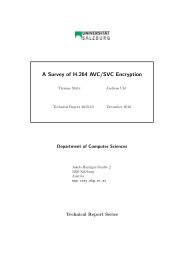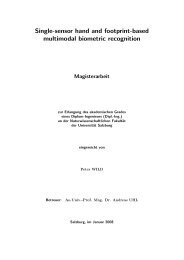Pit Pattern Classification in Colonoscopy using Wavelets - WaveLab
Pit Pattern Classification in Colonoscopy using Wavelets - WaveLab
Pit Pattern Classification in Colonoscopy using Wavelets - WaveLab
Create successful ePaper yourself
Turn your PDF publications into a flip-book with our unique Google optimized e-Paper software.
5 Results<br />
classes case all the entries on the ma<strong>in</strong> diagonal are very close to 100.<br />
From table 5.6 we see that the best test results for the tests with the pit pattern images<br />
were obta<strong>in</strong>ed us<strong>in</strong>g the feature extractors “Subband energy” and “Subband variance”. The<br />
feature vector dimensions are s = 9, 9 for the k-NN classifier and s = 50, 15 for the SVM<br />
classifier. Additionally the k-value for the k-NN classifier is very similar between the two<br />
classes case and the six classes case, with k = 22 and k = 25, respectively.<br />
For the test with the outex images, these parameters are different as we can see from<br />
table 5.7. The feature vector dimensions as well as the k-values for the k-NN classifier are<br />
lower <strong>in</strong> general. The feature vector dimensions for the classifiers are s = 1, 10 for the<br />
k-NN classifier and s = 3, 8 for the SVM classifier. The k-value for the k-NN classifier are<br />
very similar between the two classes case and the six classes case, with k = 1 and k = 5,<br />
respectively.<br />
(a) All classes<br />
(b) Non-neoplastic<br />
(c) Neoplastic<br />
Figure 5.8: Results for the WT method (2 classes, k-NN, <strong>Pit</strong> pattern images)<br />
In figure 5.8 we see the overall classification results for the two classes case for the pit<br />
pattern images <strong>in</strong> conjunction with the k-NN classifier. As we can see the best overall<br />
80








